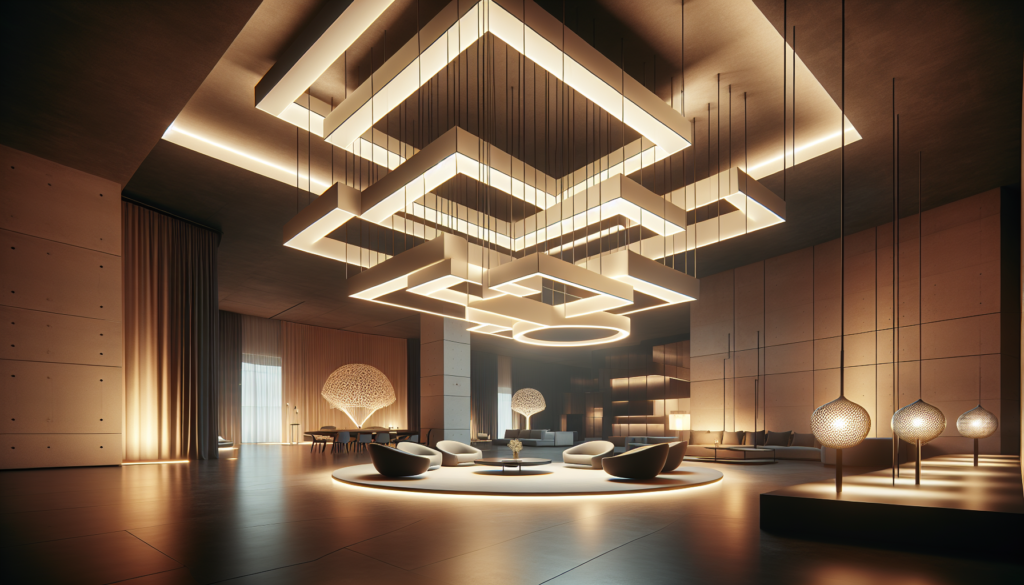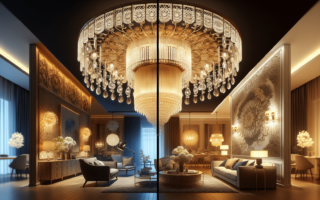Imagine walking into a room that instantly captivates your senses, with its carefully curated blend of innovative design and practicality. This is the essence of creating unique and functional contemporary lighting concepts. In a world where lighting is not just a means to brighten a space, but rather an art form that elevates the ambiance and functionality of any area, the possibilities are endless. From sleek pendant lights that effortlessly blend with modern interiors to statement floor lamps that become focal points of a room, contemporary lighting concepts offer boundless opportunities for creating a personalized and exceptional living environment.

Understanding Contemporary Lighting
Contemporary Lighting Defined
Contemporary lighting can be defined as the use of modern lighting fixtures and techniques to create an updated and stylish look in your home or space. It embraces the latest trends and designs, incorporating innovative technology and energy-efficient solutions. Contemporary lighting aims to blend functionality with aesthetics, creating a well-lit environment that complements the overall design and enhances the ambiance of the space.
Importance of Contemporary Lighting
Contemporary lighting plays a crucial role in interior design as it can completely transform the look and feel of a space. It not only provides the necessary illumination but also sets the mood and creates a welcoming atmosphere. Good lighting design can highlight architectural features, emphasize decorative elements, and create focal points. It enhances the functionality of a space by providing task lighting where needed, and it can even contribute to energy savings and sustainability.
Key Features of Contemporary Lighting
Contemporary lighting is characterized by certain key features that set it apart from traditional or classical lighting styles. These features include clean lines, minimalist designs, use of sleek and polished materials, and incorporation of innovative technology. Contemporary lighting fixtures often have a sleek and streamlined appearance, with a focus on simplicity and elegance. They are designed to be versatile and adaptable, suiting a wide range of interior styles and preferences.
Factors to Consider in Contemporary Lighting Design
Functionality
When designing your contemporary lighting scheme, it is essential to consider the functionality of the space. Analyze the activities that will take place in the area and determine the type and amount of light required. For example, task lighting is crucial in areas where specific tasks are performed, such as the kitchen or home office. Adequate ambient lighting should be considered for overall illumination, while accent lighting can be used to highlight artwork or architectural details.
Aesthetics
Contemporary lighting is known for its aesthetics and ability to enhance the overall design of a space. Consider the style and theme of the room when selecting lighting fixtures. Whether you prefer a minimalist, industrial, Scandinavian, or art deco look, there are contemporary lighting options available to suit your taste. The fixtures should complement other design elements, such as furniture, color schemes, and textures, creating a cohesive and visually appealing result.
Energy Efficiency
In today’s environmentally conscious world, energy efficiency is an important factor to consider in lighting design. Opt for LED or CFL bulbs that consume less energy and have a longer lifespan compared to traditional incandescent bulbs. Pay attention to the lighting fixtures’ energy ratings and choose those that are labeled as energy-efficient. This not only helps reduce your carbon footprint but also saves on electricity costs in the long run.
Sustainability
Sustainability goes hand in hand with energy efficiency in contemporary lighting design. Look for lighting fixtures made from eco-friendly and recyclable materials. Consider fixtures that are designed for easy disassembly and recycling when they reach the end of their lifespan. Choose manufacturers that prioritize sustainable practices and are committed to reducing their environmental impact. By selecting sustainable lighting options, you can contribute to a greener future while enjoying stylish illumination.
Choosing the Right Lighting Fixtures
Types of Lighting Fixtures
There is a wide variety of contemporary lighting fixtures available to choose from, each serving a specific purpose and adding its unique touch to the space. Pendant lights are a popular choice for creating a statement piece and providing focused task lighting. Chandeliers add a touch of elegance and sophistication, perfect for dining rooms or entryways. Wall sconces are ideal for adding ambient or accent lighting, while floor lamps and table lamps provide flexibility and versatility in their placement.
Materials and Finishes
The materials and finishes of lighting fixtures can greatly impact the overall aesthetic and style of a space. Contemporary lighting often incorporates sleek and polished materials like chrome, stainless steel, glass, and acrylic. These materials create a modern and sophisticated look, fitting well with minimalist and industrial design themes. Alternatively, natural materials like wood or bamboo can add warmth and a touch of nature to the space.
Scale and Proportion
Consider the scale and proportion of the lighting fixtures in relation to the size of the room and other elements within it. Oversized fixtures can create a dramatic and eye-catching focal point, while smaller fixtures can be used to provide more subtle and delicate lighting. Ensure that the fixtures are proportionate to the furniture and decor in the room to create a harmonious balance. Too small or too large fixtures can disrupt the overall aesthetic and functionality of the space.
Integration with Interior Design Elements
It is essential to consider how the lighting fixtures will integrate with the other interior design elements in the room. Choose fixtures that complement the style, color, and texture of the furniture, flooring, and walls. For example, if you have a room with a lot of wooden elements, consider lighting fixtures in warm tones or with wooden accents. This integration creates a cohesive and visually appealing design where all elements work together harmoniously.
Playing with Lighting Techniques
Layering Light
Layering light involves combining multiple light sources to create depth and dimension in a space. This technique adds versatility and provides different levels of illumination for various activities and moods. Start with ambient lighting as the base layer, which provides overall illumination. Then add task lighting for specific work areas and accent lighting to highlight focal points or artwork. By layering light, you can create a well-balanced and visually appealing environment.
Ambient Lighting
Ambient lighting, also known as general lighting, provides overall illumination to the space. It helps create a warm and inviting atmosphere and ensures that the entire room is well-lit. This can be achieved through recessed lights, track lighting, or even pendant lights with a diffuser to soften the light. The goal is to have a smooth and uniform distribution of light, eliminating harsh shadows and creating a comfortable environment for various activities.
Task Lighting
Task lighting is essential for activities that require focused and concentrated illumination. In the kitchen, task lighting can be provided by under-cabinet lights or pendant lights above the countertop. In the home office, a desk lamp with an adjustable arm can provide direct lighting for working or reading. Task lighting fixtures should be placed strategically to minimize shadows and glare and to provide ample light for specific tasks.
Accent Lighting
Accent lighting is used to highlight specific objects or areas, such as artwork, architectural features, or decorative elements. This type of lighting adds drama and visual interest to the space. Spotlights, track lighting, or wall-mounted fixtures can be used to achieve accent lighting. By directing light onto the desired focal point, you can draw attention to it and create a visually stunning effect.

Exploring Unique Lighting Styles
Minimalist Lighting
Minimalist lighting focuses on simplicity and clean lines, with an emphasis on functionality and understated elegance. This style embraces the “less is more” philosophy, using sleek and unobtrusive fixtures that blend seamlessly into the overall design. Minimalist lighting often features neutral colors, such as black, white, or gray, and incorporates materials like metal or glass for a modern and minimalist aesthetic.
Industrial Lighting
Industrial lighting draws inspiration from factories and industrial spaces. It embraces raw and unfinished elements such as exposed bulbs, metal fixtures, and mechanical designs. This style often features a combination of materials like metal, concrete, and wire mesh. Industrial lighting adds a rugged and edgy look to a space, perfect for those who appreciate a contemporary and urban-inspired aesthetic.
Scandinavian Lighting
Scandinavian lighting design is characterized by its simplicity, functionality, and natural elements. This style embraces minimalism and a light, airy feel. It often features clean lines, natural materials like wood and leather, and soft, diffused lighting. Scandinavian lighting creates a cozy and welcoming ambiance, incorporating elements of nature while maintaining a modern and contemporary look.
Art Deco Lighting
Art Deco lighting takes inspiration from the glamorous and luxurious designs of the 1920s and 1930s. It features intricate geometric patterns, bold colors, and luxurious materials like crystal and mirrored surfaces. Art Deco lighting creates a statement and adds a touch of elegance and sophistication to any space. It is often characterized by dramatic and glamorous chandeliers and sconces.
Incorporating Technology in Contemporary Lighting
Smart Lighting Systems
Smart lighting systems allow you to control and customize your lighting with ease. These systems often feature voice control or smartphone apps to adjust the brightness, color, and scheduling of your lights. Smart lighting can also integrate with other smart home devices, creating a connected and seamless experience. This technology provides convenience, energy efficiency, and the ability to create personalized lighting scenes to suit different moods and activities.
Wireless Control and Automation
Wireless control and automation eliminate the need for manual switches and cords, providing flexibility and convenience in lighting control. Wireless dimmers and switches can be installed to control multiple lights simultaneously, and they can be easily repositioned or relocated as needed. Automation allows you to set timers or motion sensors to turn lights on or off automatically, providing enhanced energy efficiency and security.
Advanced LED Lighting
LED technology has revolutionized the lighting industry, offering energy-efficient and long-lasting lighting solutions. LED lights consume significantly less energy than traditional incandescent bulbs, resulting in energy savings and reduced electricity bills. They also have a longer lifespan, reducing the frequency of bulb replacements. LED lighting can be integrated into various fixtures, providing versatility and style options while still maximizing energy efficiency and sustainability.

Creating Lighting Concepts for Different Spaces
Living Room
The living room is a multifunctional space that requires a versatile and well-thought-out lighting design. Consider utilizing a combination of ambient lighting, task lighting, and accent lighting to create a layered and inviting atmosphere. Use pendant lights or chandeliers as a focal point and supplement with floor or table lamps for additional light when needed. Incorporate dimmers to adjust the lighting intensity and create different moods for relaxing, entertaining, or watching television.
Kitchen
The kitchen is a functional workspace that requires both task lighting and ambient lighting. Install under-cabinet lights or recessed lights above work areas to provide adequate illumination for food preparation. Pendant lights can be used to create a focal point over the kitchen island or dining area. Consider incorporating dimmers to adjust the lighting intensity during different times of the day or when hosting gatherings.
Bedroom
In the bedroom, lighting should create a cozy and relaxing environment. Utilize a combination of ambient lighting, task lighting, and accent lighting to achieve this. Install overhead fixtures or wall sconces as ambient lighting. Consider bedside lamps or adjustable wall-mounted lights for reading or working in bed. Accent lighting can be used to highlight artwork or create a soft, romantic atmosphere. Dimmers are essential in the bedroom to control the lighting intensity and create a soothing ambiance before sleep.
Bathroom
In the bathroom, a combination of task lighting, ambient lighting, and accent lighting is necessary. Task lighting is important for grooming tasks such as applying makeup or shaving. Install vanity lights or sconces on either side of the mirror to minimize shadows on the face. Ambient lighting can be achieved through overhead fixtures or recessed lights. Consider accent lighting to highlight architectural features or decorative elements. Bathroom lighting should be bright enough for tasks but also provide a relaxing atmosphere for bathing or unwinding.
Outdoor Spaces
Outdoor lighting is essential for creating a safe and inviting atmosphere in your outdoor spaces. Consider installing pathway lights, wall sconces, or post lights to illuminate walkways and entrances. String lights or lanterns can add a festive and cozy touch to outdoor dining or gathering areas. Use spotlights or floodlights to highlight landscaping features or architectural elements. Ensure that the outdoor lighting fixtures are weather-resistant and designed for outdoor use.
Lighting Installation and Placement Tips
Lighting Plan and Layout
Before installing lighting fixtures, it is essential to create a lighting plan and layout for each space. Consider the activities and functions of the area and determine the placement of ambient, task, and accent lighting accordingly. Take measurements and ensure that the fixtures are proportionate to the space and other elements within it. Plan out the wiring and consult with a professional electrician if needed.
Appropriate Height and Placement
Proper height and placement of lighting fixtures are crucial for achieving optimal lighting effects. In general, chandeliers and pendant lights should be hung at a height that allows for comfortable interaction with the space, without obstructing views or creating glare. Task lighting fixtures should be positioned to minimize shadows and provide focused lighting where needed. Wall sconces and other accent lighting should be placed strategically to highlight specific features or objects.
Lighting Zones
Consider dividing the space into lighting zones to allow for flexible lighting control and to cater to different activities or moods. For example, a living room can have a zone for overhead ambient lighting, a zone for task lighting near a reading nook, and a zone for accent lighting to highlight artwork. By creating distinct lighting zones, you can easily adjust the lighting intensity, creating various atmospheres within the same space.
Lighting for Different Activities
It is important to have lighting options that cater to different activities performed in the space. Adjustable and dimmable lighting fixtures provide flexibility in setting the right lighting level for various tasks or occasions. Task lighting should be bright and focused, ensuring adequate illumination for specific activities such as reading, cooking, or working. Ambient lighting should be adjustable to create a cozy and relaxing atmosphere, while accent lighting can be used to create a focal point or highlight specific objects.

Enhancing Lighting Design with Accessories
Decorative Bulbs and Lampshades
Make a statement with decorative bulbs and unique lampshades. Edison-style bulbs or vintage-inspired bulbs can add a touch of nostalgia and create a warm and inviting ambiance. Lampshades come in various materials and patterns, allowing you to add personality and style to your lighting fixtures. Consider experimenting with different shapes, sizes, and colors to enhance the overall design and create an eye-catching look.
Lighting Dimmers and Controls
Lighting dimmers and controls provide the flexibility to adjust the lighting intensity and create different moods or atmospheres. Dimmers allow you to customize the lighting level for different activities or times of the day. Wireless controls or smart home systems provide convenience and ease of use. With the touch of a button or a voice command, you can control the lighting throughout your space, creating a personalized and comfortable environment.
Mirrors and Reflective Surfaces
Mirrors and reflective surfaces can enhance the lighting design by bouncing light around the room and creating the illusion of more space. Placing a mirror opposite a window or light source can help distribute natural or artificial light throughout the room. Consider incorporating mirrored furniture or decorative objects to further enhance the reflective effect. This not only enhances the lighting but also adds a touch of elegance and sophistication to the space.
Lighting Art and Installations
Lighting can also be used as an artistic element in the space. Incorporate lighting fixtures that double as artistic installations, such as sculptural chandeliers or pendant lights. These fixtures can serve as focal points and create a stunning visual impact. Consider integrating lighting into architectural features, such as recessed lights along a staircase or LED strips along a wall. By combining lighting and art, you can create a truly unique and captivating lighting design.
Maintenance and Upkeep of Contemporary Lighting
Regular Cleaning and Dusting
Regular cleaning and dusting are essential to maintaining the effectiveness and appearance of contemporary lighting fixtures. Dust accumulation can block the light output and diminish the overall illumination. Use a soft cloth or duster to clean the surfaces of the fixtures, ensuring that the bulbs and components are free from dust and debris. Clean the shades and lampshades as well, following the manufacturer’s instructions.
Bulb Replacement and Upgrading
Regularly check the bulbs in your contemporary lighting fixtures and replace any that have burned out or are not functioning properly. For energy-efficient lighting, consider upgrading to LED bulbs or other eco-friendly options. LED bulbs have a longer lifespan and consume less energy than traditional incandescent bulbs. Follow the manufacturer’s instructions for proper bulb replacement and disposal.
Professional Maintenance Tips
If you are unsure about maintaining or repairing your contemporary lighting fixtures, it is recommended to consult a professional. Some fixtures may require specialized knowledge or tools for installation, repairs, or maintenance. Professional electricians or lighting specialists can provide guidance and assistance in ensuring that your lighting fixtures are in optimal condition. Regular professional maintenance can help prolong the lifespan of your lighting fixtures and ensure their continued functionality and performance.
By understanding contemporary lighting, considering important factors in design, choosing the right fixtures, and exploring various lighting techniques and styles, you can create unique and functional lighting concepts for your home or space. Incorporating technology, creating lighting concepts for different areas, and paying attention to installation and maintenance will further enhance the overall lighting design. With proper planning and execution, contemporary lighting can transform your space into a stylish, inviting, and well-lit environment.



